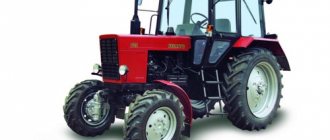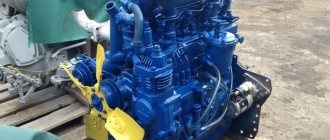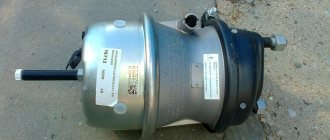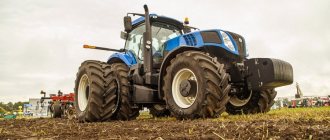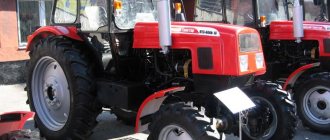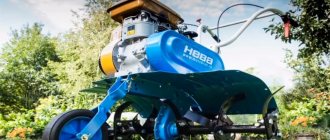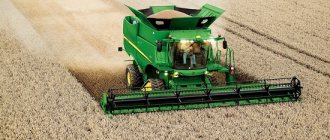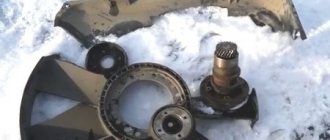In 1974, the Minsk Tractor Plant produced the wheeled universal row-crop tractor MTZ-80 "Belarus", which is still in great demand among farmers. The model MTZ-50/52, the best agricultural machinery at that time in terms of cost, reliability and performance, was taken as the basis. The car was completely modernized, received a new comfortable cabin with large glazing, upholstery and an engine of increased power.
In 1974, the Minsk Tractor Plant produced the wheeled universal row-crop tractor MTZ-80 "Belarus", which is still in great demand among farmers.
Design and diagram of the MTZ engine
The MTZ engine is a powerful device on which the performance of agricultural machinery depends. When the mixture burns in the enclosed space of the chamber, thermal energy is converted into mechanical energy, so the unit is classified as an internal combustion engine (ICE). Diesel is used as fuel. The transformation process is based on an increase in the volume of gaseous substances when heated.
When exposed to inertial forces and gas pressure forces, the piston moves and rotates the crankshaft. Through the transmission system, the torque from the crankshaft is transmitted to the drive pair of the chassis. The cylinder is cleaned and releases waste products, then filled with a new portion of the fuel-air mixture.
In MTZ-80 tractors, most internal combustion engines are 4-stroke. The work cycle is completed in 4 strokes of the piston - the distance from one extreme position (upper) to the other (lower). The process occurs in 4 steps:
- Air mass inlet.
- Air compression and diesel fuel supply.
- Expanding, or working, stroke.
- Exhaust gas release.
Belarus tractors are equipped with 4-cylinder diesel engines consisting of four working cylinders connected to a common crankshaft. The difference in the angle of position of the connecting rod journals of the crankshaft of cylinders 1 and 4 and the two middle cylinders is 180 degrees relative to the plane of rotation. Thus, when the pistons of cylinders 1 and 4 are at top dead center, the position of cylinders 2 and 3 is at bottom dead center, respectively.
The operating diagram of 4-cylinder engines can be represented as follows: 1-3-4-2.
The engine on the MTZ-80 includes 3 units:
- Cylinder block. The main body, solid cast part, to which all elements and components of the diesel engine are attached. The fuel-air mixture burns in the block.
- Crank mechanism (CSM). Transforms the reciprocating movement of the piston into rotation of the crankshaft.
- Gas distribution device. It lets in a new portion of fuel and removes exhaust gases.
Auxiliary subassemblies:
- Lubrication system. Lubricates rubbing parts to reduce friction and removes heat generated by friction.
- Cooling part. Provides operating temperature conditions for the diesel engine. Tractor engines are equipped with a liquid system.
- Fuel system (TS). Supplies fuel to the cylinders.
- Launching system (PS). Starts the power unit.
The internal combustion engine is started by an electric starter or a carburetor gasoline starting device with a nominal thrust of 10 liters. With. If there is a starting device, the engine name includes the index “L”. Some models are equipped with a pre-heater for a better start in winter.
Injection advance angle
Engine D243
Ignition of the fuel-air mixture in a diesel engine is realized through self-ignition of diesel fuel from contact with pre-compressed and heated air in the cylinders as a result of such compression.
Setting the ignition on a diesel engine involves changing the advance angle of fuel injection, which is supplied at a clearly defined moment at the end of the compression stroke. If the angle is set differently from the optimal parameters, then the fuel injection will be untimely. The result will be incomplete combustion of the mixture in the cylinders, which causes a destructive imbalance in engine operation.
It should be remembered that even minor deviations when setting the fuel injection angle can lead to serious damage to the diesel engine.
The need to install the ignition on a diesel engine yourself often arises in the following cases:
- The diesel ignition needs to be adjusted in parallel with replacing the timing belt;
- after dismantling the injection pump, it is not possible to install the fuel pump pulley according to the special marks;
One of the recommendations before starting any work related to disassembling diesel fuel equipment is the urgent need to clearly mark or refresh all marks. To do this, just apply small strokes using paint or a high-quality marker. This will facilitate subsequent reassembly and installation of the injection pump pulley, which will automatically eliminate or minimize potential ignition failures.
In electronic injection timing control systems, it is determined by the following parameters:
The advance angle request for the main injection is determined depending on the engine speed and on
the amount of fuel injected (which is a display of the load).
During startup, the injection advance angle value must be reduced to establish the start of the process
combustion near top dead center, i.e. in a position where the temperature is highest at
no combustion. To do this, the program determines the injection advance angle depending on the speed
engine and coolant temperature. From the moment the engine starts, the system must again
use the programs and adjustment values described below:
- The first adjustment is made depending on the air and engine coolant temperatures. This adjustment allows you to adapt the injection advance angle to the engine operating temperature. When the engine is warm, the injection timing can be advanced to reduce combustion temperature and therefore harmful emissions (mainly NOx). When the engine is cold, the amount of injection advance must be large enough to compensate for the increased ignition delay.
- The second adjustment is determined depending on the atmospheric pressure.
- The third adjustment is made depending on the coolant temperature and the time elapsed after starting. This adjustment allows you to increase the injection advance in the engine warm-up phase, i.e. within 30 seconds after startup. It aims to reduce combustion interruptions and instability that is very likely after a cold start.
- The fourth adjustment is determined depending on the deviation of the fuel rail pressure. This adjustment is used to reduce the injection advance angle if the pressure in the fuel rail is higher than the requested pressure value. In this case, the combustion process can become very noisy. You can compensate for this phenomenon by slightly reducing the advance angle.
- The fifth adjustment is determined depending on the exhaust gas recirculation coefficient. This adjustment is used to adjust the injection advance angle depending on the exhaust gas recirculation ratio. When the EGR ratio is increased, the injection advance angle must also be increased to compensate for the drop in cylinder temperature.
Dear visitor! We cannot answer everyone personally, but nevertheless we do not refuse consultation to anyone. In order for you to be able to troubleshoot diesel problems yourself (or with the help of a nearby car service), we have developed Online Diagnostics. This is an interactive guide that contains all the known causes of diesel engine failure and shows you how to achieve correct operation of a specific engine.
We invite you to use Online Diagnostics right now!
Source
Engine models for MTZ tractors
Most of the cars of the Belarus family are equipped with diesel engines with the names D-240, D-242, D-243, D-244 and D-245.
D-240
MTZ-80 and MTZ-82 are equipped with a D-240 engine with a common combustion chamber, water cooling and an installed mixture formation system with direct fuel injection. The power of the unit reaches 59.25 kW at a rotation speed of 2200 rpm. The first tractors had a thrust of 55.16 kW. Weight is 410 kg.
Technical characteristics of in-line cylinders:
- Working capacity - 4.75 l.
- Diameter - 110 mm.
- The amplitude of piston movement is 125 mm.
MTZ-80 is equipped with a D-240 engine with a common combustion chamber and water cooling.
The motor is heated using an electric torch EFP-8101500 or a pre-heater PZHB-200B. Diesel fuel consumption during operation is 238 g/kWh.
D-242
MTZ and YuMZ tractors are equipped with D-242 engines. They are among the first devices to use a fan mechanism with a diameter of 450 mm and a lightweight crankshaft with a pulley size of 170 mm.
Technical and operational parameters of the D-242 tractor engine:
- Cylinder capacity - 4.75 liters.
- Diameter - 110 mm.
- Piston stroke - 125 mm.
- Fuel consumption - 226 g/kWh.
- Power - 46 kW.
- Rotational speed - 1800 rpm.
- The highest torque is 278 N*m.
- Weight - 430 kg.
D-243
The D-243 engine is intended for tractor equipment designed for 14-20 kN, used with unlimited exchange of air mass without a turbocharger and operated at temperatures of -45...+40°C. The diesel engine is available in 2 modifications: D-243L and D-243.1. On a motor with a P-10UD starting device, the PS is controlled remotely. Modifications 243 and 243.1 are started using a starter 24.3708 and differ in power parameters. Thus, the power of D-243 is 59.6 kW, D-243.1 - 61 kW.
The D-243 engine is used for unlimited exchange of air mass.
Basic indicators:
- Working capacity - 4.75 liters.
- Rotational speed - 2200 rpm.
- The highest power moment is 298 N*m.
- Fuel consumption - 226 g/kW*h.
- Weight - 430 kg.
D-244
The D-244 engine with a crankshaft that does not contain counterweights is equipped with MTZ tractors, mini-tractors and other agricultural machinery. The main differences between the engine and its analogues are:
- Power - 41.9 kW.
- Rotation speed - 1700 rpm.
- Torque - 271 N*m.
Model D-245
The diesel unit D-245 is the latest model in the family. It is produced in the following versions:
- D-245 and 245L - with turbocharging. Options:
- thrust - 77 kW;
- frequency - 2200 rpm;
- highest torque - 384 N*m;
- fuel consumption - 220 g/kWh;
- device weight - 450 kg.
- D-245.2 - with turbocharging and charge air cooling, with a power of 88 kW and a torque of 439 N*m. The weight of the model is 470 kg. Starter 20.37-8 is used as a PS. Turbocharger - TKR-6 or S1470V/8.12 M.
- D-245.4 and 245.5 - with turbocharging. Traction characteristics - 60 and 65 kW at a frequency of 1800 rpm. The calculated maximum moment is 366 and 397 N*m. Turbocharger - TRK-6-01 or S1470V/6.12M.
The D-245 engine is produced with turbocharging and supercharged air cooling.
Design features include:
- Availability of a turbocharger.
- Changes to the supply and return manifold pipes, crankshaft pulley, generator set and water pump.
- Auxiliary V-belt.
- Special nozzles in block supports.
- Cast iron insert under the first ring of the compressor.
- Anti-smoke corrector.
- Improved push-in valve seats and oil pump.
- Lengthening the flywheel pins.
Difference between inserts d-240 and d-245. Interchangeability of d-240 and d-245
Engines for VAZ
What is the difference between inserts D-240 and D-245?
Is it possible to install some earbuds instead of others?
This question is often asked during repair work on diesel engines D-240 and D-245 associated with the crankshaft.
Geometrically, these liners are absolutely identical.
The main difference is the material from which the earbuds are made.
Material of inserts D-240: Steel-aluminum AO-10 C2
Material of inserts D-245: Steel-bronze (with galvanic coating)
Also, the liners differ in price: D-245 is always more expensive due to more expensive material.
The replacement of material on the D-245 liners was due to the increased boost of this engine due to the use of a turbine.
Is it possible to install D-245 liners on a D-240 motor?
It is possible, but they will cost more and there is no particular point in this, because... “native” earbuds behave no worse.
Is it possible to install D-240 liners on a D-245 motor?
This is also possible, but this is strongly not recommended, because... They are not designed to work with increased load.
Bottom line: to avoid problems after engine repair, you need to install liners that are designed for a specific type of engine, i.e. inserts for D-240 are installed on naturally aspirated engines, and inserts for D-245 are installed on turbocharged ones.
Still have questions?
Call
What do the letters and numbers on the inserts D-240, D-245 mean?
Dimensions of inserts D-240 and D-245 in millimeters
recommended products
Buy D-240 main bearings N1 Tambov, 50-1005100B, Tambov Plain Bearing Plant, Incl..
Buy D-240 main bearings P1 Tambov, 50-1005100B, Tambov Plain Bearing Plant, Incl..
Buy D-245 main bearings N1 Tambov (steel-bronze), 245-1005100-ATB, Tambov bearing plant..
Buy D-245 main bearings P1 Tambov (steel-bronze), 245-1005100-ATB, Tambov bearing plant..
Buy D-240 connecting rod bearings N1 Tambov, 50-1004140A, Tambov plain bearing plant, Incl..
Buy D-240 connecting rod bearings P1 Tambov, 50-1004140A, Tambov plain bearing plant, Incl..
Buy D-245 connecting rod bearings N1 Tambov (steel-bronze), 245-1004140-ATB, Tambov bearing plant..
The most common breakdowns of models
Typical problems with tractor engines include:
- Air in the vehicle. To eliminate the problem, pump it with a manual pump and eliminate the suction.
- Vehicle malfunctions and defects. The pump is removed and sent to a service station for diagnosis and repair.
- Lack of traction. They repair the vehicle - adjusting the pump, replacing the filter if clogged, washing the nozzles, cleaning the nozzle, checking the air cleaner, turbocharger, adjusting the valve clearances.
- Black smoke appears. Possible causes are clogging of the air cleaner, malfunction of the fuel supply pump and injectors, incorrect adjustment of the thermal clearances of the gas distribution mechanism. Carry out maintenance or replacement of elements and appropriate adjustments.
- The appearance of white smoke. The reason is that coolant gets into the combustion chamber of the engine. Malfunction - the gasket between the engine block and the gas distribution head is broken. Remedy: dismantling the head and replacing the gasket.
- Radiator coolant boiling. Clean the radiator and water jacket of the cylinder block from scale, and adjust the tension of the fan belt.
To prevent the above listed malfunctions of a diesel unit, it is necessary to carry out timely and adhere to the rules of operation and maintenance of the engine established by the manufacturer.
Reviews
- Konstantin, Smolensk. The Belarus MTZ-82.1 tractor was purchased last year for several hundred thousand rubles. The car is completely worth the investment. Although the cabin is cramped, all controls are absolutely functional - there is ventilation and heating. All machine kits are of quite high quality and have a long service life. I would like to note good maintainability and low cost of spare parts. The machine can be serviced in a garage or field conditions. The tractor is well suited for construction and road work. Our employees use the machine both in public utilities and in loading and unloading operations. The hydraulic suspension system is quite simple and therefore reliable. No complicated electronics, and everything works without any interruptions. The tractor can be mounted with a variety of attachments. The engine power, however, is only limited and it often overheats. It is necessary to regularly clean the cooling system and oil channels. MTZ-82.1 is undemanding in terms of fuel quality and is very economical due to its low weight.
- Anton, Leningrad region. Our farm uses an all-wheel drive version of the Belarus MTZ-82.1 tractor. Such a machine moves more confidently on muddy ground, deep ruts and holes. The tractor overcomes any obstacles and is designed for a wide range of tasks. To do this, we have the necessary attachments, including wide-cut attachments and trailers. The simple design and high load capacity made this tractor universal, but low reliability and frequent breakdowns spoil the impression. I'm glad that the spare parts are cheap and can be found on the secondary market.
Specifications
Number of gears: - forward18 - reverse4 Travel speed, km/h: - forward2 - 34.5 - reverse4.1 - 10.1 Rear PTO: - dependent I, rpm 540 - dependent II, rpm 1000 - synchronous I, rpm 3.4Front drive axle - with the ability to adjust the front wheel track by extending the cams, with bevel gears.
Brakes : working - disc, on the shafts of the drive gears of the final drives;
The parking brake is a disc brake, connected by a brake shaft to the differential crosspiece, and independently manually controlled.
The trailer brake drive is pneumatic, interlocked with the tractor brake control.
The clutch is a friction, single-disk, permanently closed type with mechanical control. The clutch linings are asbestos-free (cermet-metal upon request).
The gearbox is mechanical, stepped, with a mechanical reduction gear.
The rear axle has a final drive, differential and final drives, and also has the ability to change the track by doubling the wheels using a spacer.
Lateral semi-independent PTO
Lateral semi-independent PTO - two-speed 571 rpm and 755 rpm. The direction of rotation is counterclockwise when viewed from the end of the shank; PTO 1s shank GOST 3480 (8 teeth), PTO 1 (6 teeth).
Rear three-point tractor linkage of the second category according to ISO 730 and NU-2 according to GOST 10677 with external or internal locking of the lower links.
Steering
At the buyer's request, the MTZ 82.1 tractor can be equipped with one of the following types of steering:
- hydrovolumetric _ The power pump is a gear pump with a left-hand direction of rotation. The metering pump is gerotor, with an open center, without steering response. The type of rotation mechanism is a double-acting hydraulic cylinder and a steering linkage.
- hydromechanical (installed upon request). The power pump is a gear pump with a left-hand direction of rotation. Type of rotation mechanism - worm, helical sector and hydraulic booster;
- hydrostatic with a metering pump on the hydraulic booster housing (optional on the BELARUS-82.1 tractor with an awning frame or an awning base based on a small cabin). The power pump is a gear pump with a left-hand direction of rotation. The metering pump is gerotor, with an open center, without steering response. The type of rotation mechanism is a double-acting hydraulic cylinder and a steering linkage.
Specifications
Length, mm 4120 Width, mm 1970 Cabin height, mm 2800 Tractor base, mm 2450 Track, mm: - front wheels 1430 - 1990 - rear wheels 1400 - 2100 Agricultural clearance, mm 645 Smallest turning radius, m 4.4 Operating weight, kg 4000 Tire sizes: - front wheels 11.0 - 20 - rear wheels15.5R38Chassis
The running system of the MTZ 82.1 tractor is built on a 4x4 wheel arrangement in such a way that it ensures high driving performance, ease of control and maintenance of the tractor. The suspension of the rear wheels is rigid, the front wheels are balanced, this is explained by the dual task of driving and steering the front wheels.
Front drive axle MTZ 82.1 - with main gear, self-locking differential, final drives, with bevel gearboxes, can, if necessary, be turned off to save fuel.
Factory equipment:
- seat adjustable according to driver's weight and height;
- rear view mirrors;
- sun visor;
- electric windshield wipers for front and rear windows.
The MTZ 82.1 tractor cabin is additionally equipped with a single seat. The cabin doors have locks, the left door has keys. The right door is an emergency exit. The cabin complies with category 2 according to EN 15695-1:2009.
Cabin
The MTZ 82.1 cabin is attached to the tractor frame with rubber shock absorbers, which reduces vibration levels and increases the noise insulation qualities of the cabin. The cabin doors are also covered with soundproofing material.
The MTZ 82.1 cabins are heated by extracting heat from the hydraulic system. Ventilation - opening the doors and roof of the tractor.
